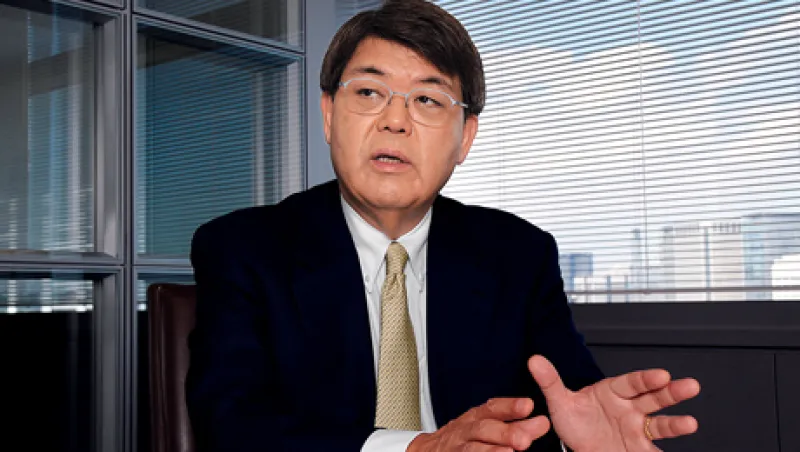Shuhei Abe, president and CEO of Sparx Group Co., spent decades outwitting the volatile Japanese equity market. After founding Sparx in his Tokyo apartment in 1989, Abe grew it into Asia’s largest hedge fund firm despite his country’s economic sluggishness; in 2007 its assets under management peaked at $15 billion. But the financial crisis hammered Abe’s shop, which focuses on Japanese companies and the Asian companies that do business with them. Publicly traded Sparx hasn’t made money since fiscal 2009, when it squeaked out a net profit of ¥398 million ($4 million) after losing ¥23.3 billion the previous year. Although redemptions have been modest, its assets now stand at about $7 billion.
These troubles pushed Sparx, whose strategies include long-short equity and global macro, to rethink its view of Japan as a market distinct from the rest of Asia. “In the past, after the winter storm finished, spring comes and summer comes,” says Abe, 57, at the firm’s Hong Kong offices. “However, this time I realized I cannot wait for next spring and summer because the change is more structural. I realized that investing in Japan and Asia with separate strategies would not work and that we should look at Asia as one system.”
That’s exactly what Abe did as part of his recent overhaul of Sparx, which manages its funds through three subsidiaries, in Japan, Hong Kong and South Korea, mostly for global institutional investors that include sovereign wealth funds and public pensions. Since 2009 the Sapporo native, who briefly worked for George Soros’ Quantum Fund in the early 1980s, has slashed the firm’s head count by nearly half, to 180. He’s also cut annual costs by more than 60 percent.
But the biggest change is a new regional perspective. Over the past year Abe has combined his research teams in Tokyo, Hong Kong and Seoul. Though most of Sparx’s assets are in Japan and South Korea, Hong Kong plays a central role in the “one Asia” strategy. Last June, Sparx renamed its Hong Kong division Sparx Asia Investment Advisors.
Abe has dispatched Masaki Taniguchi, previously head of Tokyo-based Sparx Asset Management Co., to Hong Kong. Named group COO in April, Taniguchi grew up in Taipei and speaks, reads and writes Chinese. “Before, people looked at Japan and Asia as two separate markets,” says the 40-year-old, who was a vice president at Goldman Sachs Asset Management in Japan before he joined Sparx in 2002. “It was developed countries like Japan manufacturing in cheap-labor countries like China and shipping finished products back to developed nations. Now the supply chains are more diversified.”
Taniguchi cites Apple’s iPad as an example: California-based Apple designed its tablet with various Japanese-made components, including NAND flash chips from Toshiba Corp. and touch-screen overlay glass from Asahi Glass Co., but it uses Taiwan’s Foxconn Technology Group for final assembly in China. For Sparx, the iPad supply chain shows why it must consider Asia as a whole cut to make the best investment decisions. In this case it would go long the component manufacturers when iPad sales were strong and short them when prospects diminished.
Sparx is applying the same pan-Asian approach to other industries. Its Japan-based automotive analysts used to look only at Japanese automakers; they now compare those companies with established rivals in South Korea and future competitors in China. To get the big picture, Abe has formed a core investment team of seven fund manager-analysts backed by research analysts throughout the region. “We look for implications for companies across Asia and try to pick winners and losers,” he says.
Abe, who has an MBA from Massachusetts’ Babson College, is no stranger to fundamental research. Before founding Abe Capital Research in 1985 to manage Japanese equities for U.S. and European investors, he worked as an analyst with Nomura Research Institute.
The Sparx CEO thinks several trends will influence his firm’s future performance. First, rising labor costs in China will create investment opportunities. Sparx is shorting Chinese companies hurt by higher wages and taking long positions in Japanese robotics makers that help China to automate manufacturing. Despite the yen’s appreciation, Japanese companies with sought-after manufacturing technology can raise their prices.
Also, Abe expects Asia to become the world’s growth engine as China, India and Southeast Asia keep rising. Regionwide he predicts average annual economic expansion of 8 percent for years to come. Meanwhile, he says, government initiatives such as renewable energy programs will boost demand for innovative Japanese technology.
There are signs that Abe’s pan-Asian strategy is working for Sparx, whose $750 million Japan Long-Short Strategy returned an annualized 0.66 percent for the three years ended October 31, compared with –4.13 percent for the Topix. The $25 million Hennessy Select Sparx Japan Institutional fund was up 1.21 percent year-to-date through November 30, while the Topix fell 18.95 percent. Sparx could be shaking off winter’s chill.






